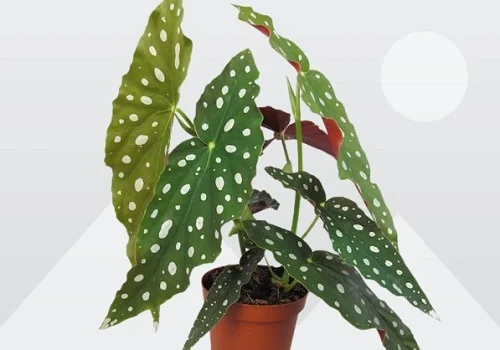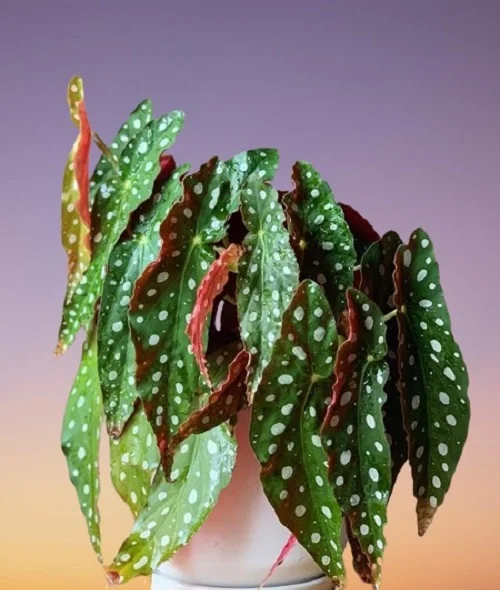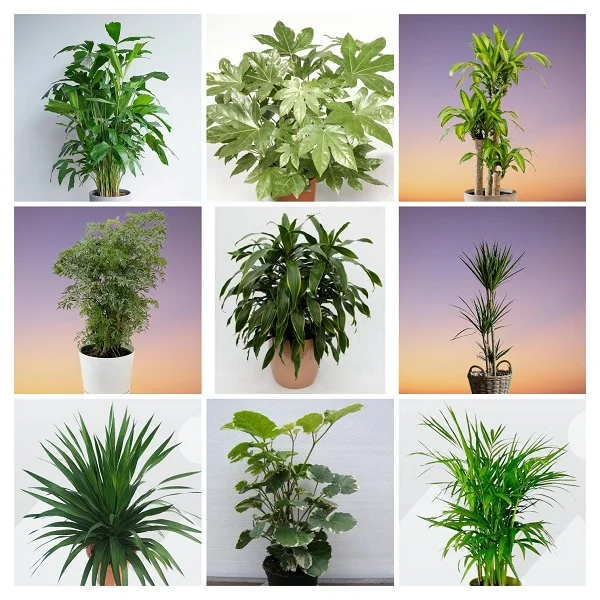Begonia maculata (Polka Dot Begonia) Care Indoors, Propagation, Problems & Solutions
Some links in this post may be affiliate links
Begonia maculata (Polka Dot Begonia) flourishes in bright indirect light, warm and humid conditions, and consistently moist, fertile, well-drained soil coupled with weekly feeding in the growing season.
Polka Dot Begonia also called Trout Begonia or Spotted Begonia is among the popular Begonia varieties and bears large, glossy, olive-green leaves blotched with white dot-like spots and hence the common name.
The undersides of the leaves are beautifully red-colored. Trout Begonia may be less spectacular in bloom than other Begonias but has the advantage of keeping its beautiful "Angel Wing" leaves through out the year.
Spotted Begonia like Begonia coccinea (Angel Wing Begonia) is a popular, evergreen, shrubby, flowering, cane-stemmed Begonia which easily adapts to indoor growing conditions and is also easy to propagate from stem cuttings.

Botanical name: Begonia maculata
Family: Begoniaceae
Common names: Polka Dot Begonia, Trout Begonia, Spotted Begonia
Origin
Begonia maculata is native to the tropical regions of Brazil.
Size
Spotted Begonia can reach the height of 8 feet or more if left unpruned. On account of its large, spectacular foliage, Trout Begonia like Begonia Corallina de Lucerna is one of the large-leafed indoor plants that make a bold statement.
Flower
Trout Begonia flowers are large clusters which hang beautifully from the stems.
Is Begonia maculata toxic?
Yes. All parts of Begonia maculata (Polka Dot Begonia) and especially the roots are considered toxic to pets as outlined by ASPCA. If ingested it may cause burning in the mouth and throat, vomiting, diarrhea and abdominal pains.
Where to Buy
If you are looking to add Begonia maculata to your collection, you acquire these plants online from Etsy (Link to Etsy).
How to Care for Begonia maculata Indoors
To care for Begonia maculata indoors, give it bright indirect light (filtered light), warmth of 18-260C, humidity of 50-55% and consistently moist, fertile, well-drained soil coupled with weekly feeding during the growing season.
Polka Dot Begonia requires repotting only when extremely pot-bound as it grows best when slightly root-bound. Regular pruning is needed to keep it neat, to reduce pest infestations and to rejuvenate growth. Keep reading for more on theese growing conditions and how to achieve them.

Watering
How often do you water Begonia maculata?
Water your Begonia maculata liberally in spring and summer and allow the top 1-2 inches of soil to dry out between waterings. Keep the soil consistently moist but not soggy to avoid rotting, yellowing and leaf drop.
Reduce watering in fall and winter to keep the soil slightly moist as growth is minimal at this time. Do not allow the soil to dry out completely to prevent wilting, drooping, leaf loss and flowerbud drop.
Use water that is at room temperature to avoid cold shock which may result in stunted growth, leaf fall and reduced flowering. Only water with chlorine-free water to avoid browning of leaf tips and edges.
Make sure that the soil is free-draining and the pot has a drainage hole to prevent the soil from getting soggy as it can lead in root-rot and loss of the plant.
Light Requirements
Do Polka Dot Begonias like full sun?
No. Polka Dot Begonia grows best in bright indirect light (dappled light). Keep it away from direct sunlight to prevent scorching of the leaves.
If the light is too low, the leaves may begin to yellow and the plant may not flower. Where the natural lighting is not adequate, you may use a full spectrum grow light to supplement it.
Rotate the pot regularly to ensure that the plant receives light on all sides for a uniform growth as well as prevent legginess.
Temperature & Humidity
Begonia maculata prefers an average warmth of 18-260C with a minimum 150C. Lower temperatures will result in reduced growth, leaf drop and eventual death of the plant.
Keep it away from sources of drafts to prevent sudden changes in temperature as they may cause stunted growth, leaf loss and flowerbud drop.
Polka Dot Begonia has no need for high humidity; average humidity of 50-55% is adequate for this plant. However, where the room temperatures are too high causing the air to be too dry, raise humidity by setting the pot on wet pebble tray, grouping the plants together or by use of a cool mist humidifier.
Fertilizer
Feed Begonia maculata with a balanced, liquid fertilizer every week in spring and summer to promote a healthy growth. To promote blooming, apply a phosphorous-rich, water-soluble fertilizer weekly when buds begin to form.
Stop feeding in fall and winter as growth is minimal at this time and feeding at this time can cause fertilizer burn and death of the plant.
Potting Medium
The best potting mix for Begonia maculata should be rich in organic matter and free-draining to prevent it from getting soggy while providing the required nutrients. A mix of 2 parts of all purpose potting mix and 1 part perlite is recommended for this plant.
Repotting
Repot Polka Dot Begonia at the beginning of the growing season (spring to early summer), only if the plant has become root-bound or is too large for the pot as the plant prefers to be slightly root-bound.
Use a pot 1 size larger than the current one to avoid overpotting it which can result in the soil staying wet for too long. Ensure the pot has a drainage hole and the soil is well-draining to prevent waterlogging which can lead to rotting and death of the plant.
Do not repot a flowering Spotted Begonia as the shock of repotting can cut short the flowering period. Check out these self-watering pots on Amazon.
Pruning & Maintenance
Pruning Begonia maculata entails removal of the dead flowers, yellow and dead leaves to keep the plant neat and reduce pest infestations. Do not pinch the growing buds as this is where the flowers emerge from.
Cutback the bare stems with a sharp, clean pair of pruning scissors at the beginning of the growing season to rejuvenate growth. The foliage emanating from the pruning can be used to propagate new plants.
Occassionally clean the leaves by damp-wiping with a soft cloth to get rid of dust as well as minimize pests and diseases infestations.
Begonia maculata Propagation
Begonia maculata is propagated from stem cuttings at the beginning of the growing season (spring to early summer) while in active growth to encourage establishment. The cuttings can be rooted either in water or in soil.
1. Polka Dot Begonia propagation from stem cuttings in soil
- Select a healthy stem (4–6 inches long) with at least two leaves and two leaf nodes.
- With a sterilized pruning scissors cut just below a leaf node as this where new growth will come from.
- Strip off the lower leaves, leaving only the top ones.
- Dip the lower cut end in a rooting hormone to hasten establishment.
- Fill a small pot (6-8 inches) with a well-draining rooting mix and moisten it slightly.
- Insert 2-3 inches of the lower cut end of the cutting in the moist rooting mix.
- Place the set up in a warm, well-lit place away from direct sunlight to avoid scorching.
- Maintain the soil moist until new growth emerges. Roots will develop in 2–4 weeks.
- Allow the new plant to be well established before transplanting after which you can begin routine care.
2. Polka Dot Begonia propagation from stem cuttings in water
- Select a healthy stem (4–6 inches long) with at least two leaves and 2-3 leaf nodes.
- With a sterilized scissors cut just below a leaf node as this where new growth will come from.
- Strip off the lower leaves, leaving only the top ones.
- Dip the lower cut end in a rooting hormone to promote establishment.
- Place the cuttings in a jar of plain water or in a propagation station. Change the water every 5-7 days.
- Position the set up in a warm, well-lit place away from direct sunlight to avoid scorching.
- When the roots are about 2-3 inches, transfer the cuttings into individual pots in moist, rooting soil.
- Maintain the soil moist until new growth emerges.
- Allow the new plant to be well established after which you can begin routine care.

Begonia maculata Problems & Remedies
Begonia maculata (Polka Dot Begonia) problems are leaf loss, flowerbud drop, plant dying, diseases and pests among others. Keep reading for more on these problems and how to solve them.
Leaf loss
Why is my Begonia maculata losing leaves?
Your Begonia maculata is losing leaves due to too little light, temperature stress, inconsistent watering, soggy soil or consistent use of cold water.
How to fix it
Too little light: Position the plant in a brighter place where it will receive bright indirect light or instal a grow light if the natural light is not enough.
Temperature stress: Keep the plant away from sources of drafts like AC units, hot air vents, hot stoves, windy doors, drafty windows among others.
Inconsistent watering: Do not water on a schedule. Water when the top 1-2 inches of soil feel dry to the touch.
Soggy soil: Pot it in free-draining soil and a pot that has a drainage hole.
Use of cold water: Water with water that is at room temperature to avoid cold shock.
Flowerbud drop
Flowerbud drop on Begonia maculata is caused by dry air, drafts, underwatering or watering with cold water.
How to fix it
Dry air: To elevate humidity, set the pot on a wet pebble tray, use a cool mist humidifier or grow the plant in a well-lit bathroom and other moist areas in the home.
Drafts: Keep the plant away from drafts originating from AC units, hot air vents, stoves, windy doors and others.
Underwatering: Maintain the soil consistently moist in spring and summer and slightly moist in fall and winter. Never allow the soil ball to dry out completely.
Use of cold water: Use water that is at room temperature water to avoid cold shock.
White powdery spots
White powdery spots on Begonia maculata are an indication of powdery mildew which is brought about by over damp conditions, low temperatures and poor air circulation.
How to fix it
- Isolate the affected plant and cut off the diseased leaves to minimize spread.
- Spray the plant with a systemic fungicide as per the manufacturer's instructions..
- Improve ventilation to ensure that there is good air circulation for the plant.
- Avoid wetting the foliage during watering or water from the bottom instead.
- Maintain the temperatures at an average warmth and keep the plant away from cold drafts which cause sudden drops in temperatures.
Brown blotches which turn grey and moldy
Brown blotches which turn grey and moldy on Begonia maculata are an indication of botrytis disease which is promoted by overwet conditions coupled with poor ventilation.
How to fix it
- Isolate the affected plant and cut off the diseased parts.
- Spray the plant with a systemic fungicide. Ensure all the parts of the plant are well covered with the fungicidal solution.
- Avoid overwet conditions by ensuring that the soil is well-drained and the pot has a drainage hole.
- Maintain good air circulation for the plant to discourage the disease.
Plant dying
There are three possible reasons why your Begonia maculata is dying.
1. Stem-rot disease which is enhanced by soggy soil (too wet soil). Discard the affected plant to minimize spread to other plants as it cannot be saved.
2. Nematodes (root knot eelworm) which are characterized by swollen bumps on roots.
3. Vine weevil which is characterized by tunnels in the rhizomes.
Pests
Common pests on Begonia maculata are aphids and spider mites. Maintain the plants healthy at all times to minimize pest infestations.
How to fix it
- Isolate the affected plant to prevent spread to the other plants.
- Treat the plant with neem oil or an insecticidal soap. Ensure to follow the manufacturers' instructions on the label.
- Regularly damp-wipe the leaves with a soft cloth to discourage the pests.
- Maintain the plant well pruned to discourage the pests.
- Set the pot on a wet pebble tray or group the plants together to elevate humidity to minimize the pests infestations.
You liked it? Share on social media.
Related Content
Amazon Associates Disclosure
Homeplantsguide.com is a participant in the Amazon Services LLC Associates Program, an affiliate advertising program designed to provide a means for sites to earn advertising fees by advertising and linking to amazon.com.





